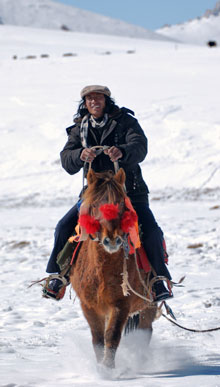Related resources

Learning from Canada's Northern Parks
Study tour from the Tibetan plateau to northern Canada, exchanging lessons and experiences on partnerships with local communities and co-management...
Nahanni as a role model
Kassina Ryder, Northern News Services, October 21, 2010
LIIDLII KUE/FORT SIMPSON - An international non-profit organization aimed at balancing grassland preservation with indigenous people's land access in the Tibetan Plateau Region of China are looking to Nahanni National Park Reserve for inspiration.
China has created a nature reserve on the Tibetan plateau, but it has come at a great cost to many of the people who live within the park's boundaries, according to the general manager of Plateau Perspectives Gong Bu Zha Xi.
"There is some conflict with the local people," Xi said.
Many of the people who lived and grazed their animals on the grasslands for thousands of years were relocated from certain areas when the Sanjiangyuan National Nature Reserve was created, Xi said.
"People lost their jobs and their culture and also their livelihoods," he said. "The people moving to the cities and towns, they don't know what to do. They are herders and grassland people."
Xi and his organization are researching ways local inhabitants can play a role in the future of the reserve, he said.
That's why he travelled to Fort Simpson the week of Oct. 11 to visit with Parks Canada staff and discuss how they have worked with the Dehcho First Nations in developing the Nahanni National Park Reserve (NNPR).
"Local people are still living in this area, this is a very important idea for us," Xi said.
"How to co-manage, these are the things I have to learn."
Jerry Antoine, Parks Canada interpreter officer, said co-operating with local residents is the only way to successfully manage a new park.
"Working in partnership is really crucial," he said. "It's good."
Parks Canada conservation biologist Douglas Tate agreed.
"It's important just having local people involved in park management right from the beginning," he said. "Get local people's thoughts and opinions and if there are differences of opinion, those can be worked out."
While the park is now accepted, Antoine said the park was not welcomed by all Dehcho First Nations people when it was first established in 1976.
"The community people weren't necessarily opposed to it," he said. "What they voiced was that when it initially got introduced, there were some promises made, which for them weren't fulfilled."
Antoine said some people felt that there wasn't enough of a Parks Canada presence in Nahanni Butte, which they had been told would happen.
"They viewed there would be involvement from the community, they still view that as one of their interests," he said.
The opening of a temporary Parks Canada office in Nahanni Butte has now fulfilled that promise, Antoine said.
Tate gave a presentation to Xi showing how all aspects of the park are operated, including the creation of the Naha Dehe Consensus Team in 2000.
The team was created to aid in planning the expansion of the park and now helps to co-manage the NNPR.
Antoine said the team acts as the voice of the Dehcho First Nations and helps show people they have a say in how decisions are made.
"The consensus team is the vehicle for the relationship to blossom and to move forward on the co-management of the park," he said. "It's an instrument that people feel is needed to assist in the process."
Xi said the organization is also interested in how park staff perform wildlife research and how to balance the needs of animals with the needs of the people who rely on them.
"In recent years, the wildlife numbers are increasing," Xi said. "Because their numbers are increasing, the wildlife/human conflict is increasing."
Xi said wild donkey and wild antelope compete with herders' livestock grazing on the grasslands, which is causing problems for both the animals and the people.
He added growing animal populations are also increasing grazing pressure on the grassland's flora.
"(We're) protecting wildlife and creating more problems. So how to limit the number is one of the important questions for us," Xi said.
Xi said he was especially interested in the hunting policy in NNPR. Dehcho First Nations are given unlimited access to the park and its wildlife, while there is a strict no hunting policy in the Sanjiangyuan National Nature Reserve, Xi said.
"Here local people can hunt in the parks. We couldn't because in China they said if you allow people to go hunting, it's easy to lose control," he said. "Now we're discussing how to keep the balance."
Nahanni Park also employs locals for certain positions and Xi said his organization would like to see the same thing happen in the Sanjiangyuan National Nature Reserve.
"We are also doing some wildlife monitoring," he said. "There is technology we have to learn and (we want) to train local people to do some monitoring."
Xi said he believes the management of Canadian parks should serve as an exampleto the internationalcommunity.
"In Canada the parks have a very good system established it's kind of the model for all of the world," he said. "It's really good for us to come here and learn."